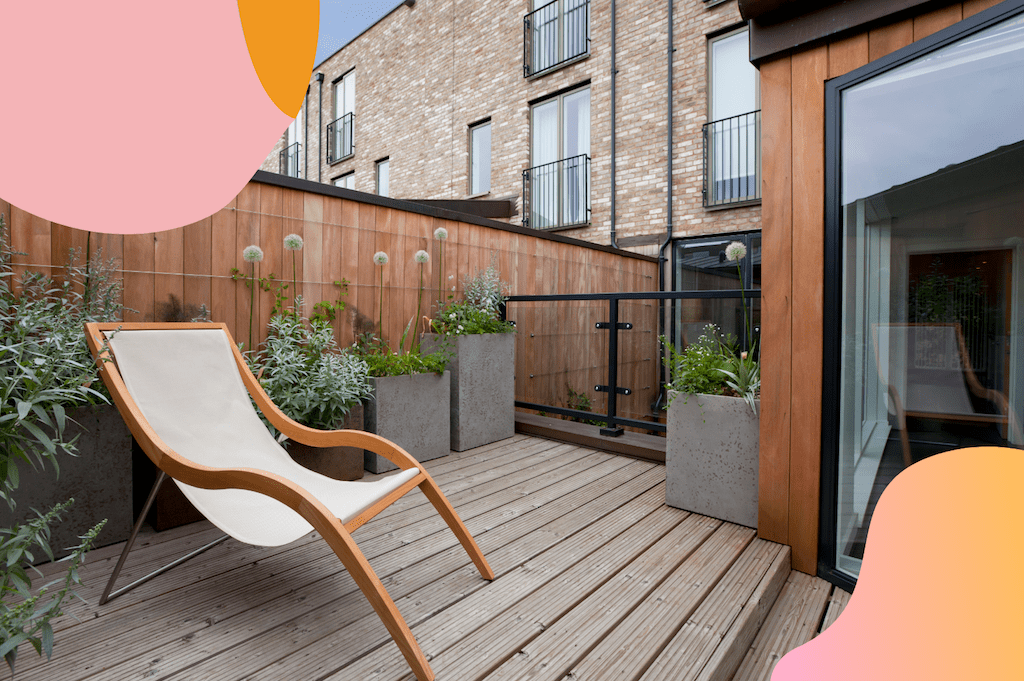Whilst it’s verging on the perverse to bring up the onset of autumn as the new breaks about summer 2025 being the hottest on record, just like the inevitable passing of time it’s something we simply have to look straight in the eyes, as we ponder another summer coming to an end.
Indeed, with September approaching and the occasionally balmy days threatening to frost over before too long, gardeners across the UK are beginning to consider packing up the garden furniture, adding a new layer of Ronseal to the decking, and preparing their green spaces for the chilly embrace of autumn.
But this shouldn’t mean that the UK’s gardens are a barren wasteland come the chillier seasons. In fact, with the right planning and creativity, your garden can transform into a sheltered sanctuary to relish, even as temperatures cool. With that in mind, here are 11 garden zoning ideas for autumn.
Cosy Fire Pit Zone
Nothing says autumn quite like huddling around a crackling fire pit, bangers bursting and spiced cider getting sipped amidst the crisp air. Firstly, you need to select a hardy, fire-resistant surface area in your garden to establish a fire pit. Some of the safest surfaces include:
- Patio Slabs/Stone Pavers: These provide a heat-resistant and stable base for your fire pit. They also come in various shapes, designs, and colours, allowing you to match it with your garden aesthetic.
- Concrete: A concrete pad can provide a safe and solid base for a fire pit. It’s resistant to heat and can handle the weight of a fire pit with ease.
- Crushed Stone/Gravel: Crushed stone or gravel allows for good drainage and prevents any flammable material from being under the fire pit.
- Fire-Resistant Mat: These are specifically designed for use with fire pits, and they’re made from heat-resistant materials. They can be placed under the fire pit on any surface, including wooden decks.
- Brick: It’s quite resistant to heat and provides a classic, rustic look.
- Sand: A thick layer of sand underneath your fire pit can act as a heat buffer.
Around this focal point, arrange comfortable seating, using warm-toned cushions and blankets for a greater sense of cosiness.

Colourful Autumn Borders
As the experts at Jacksons Nurseries encourage, it’s essential to plan ahead by cultivating plants that produce vibrant autumnal hues for a gorgeous autumn spectacle. There are several plants that thrive in the UK’s autumn climate, offering vibrant colours and spectacular displays.
One of them is the Acer tree, also known as the Japanese Maple, which provides a beautiful range of autumn colours, from fiery reds to deep purples. They are relatively easy to grow and can be planted in containers or directly in the ground.
Astilbe, a perennial plant, comes into its own in the autumn. It has feathery, plume-like flowers and fern-like leaves, which look particularly striking when they turn a golden brown colour in the autumn.
Sedum, also known as Stonecrop, is another great option. In the late summer and autumn, it produces clusters of star-shaped flowers that are a magnet for bees and butterflies. The flower heads remain attractive even after the blooms fade, providing interest throughout the winter.
Michaelmas Daisies – also known as asters – are perfect for adding colour to your garden in the autumn. These daisies, named because they bloom around the time of Michaelmas Day (September 29), come in a variety of colours, including purple, pink, and white.
Finally, consider planting grasses like Eulalia (Miscanthus Sinensis). In the autumn, this ornamental grass produces feathery plumes and its leaves turn to a lovely golden colour. It’s perfect for adding texture and interest to beds, borders, and containers.
These plants create a border that not only provides privacy but also adds a captivating cascade of ruby reds, burnt oranges and golden yellows to your garden landscape, though though do be aware that they should all be planted in early spring if it’s to be abundant by autumn. This one really is about playing the long game, we think.
Boundary Fencing For Privacy & Aesthetics
As the leaves begin to fall and the days grow shorter, ensuring your garden remains a private and inviting space becomes even more important. Consider upgrading or installing boundary fencing to create a defined, secure perimeter around your garden. Opt for materials that complement the autumnal palette, such as wooden panels stained in rich, warm tones or metal fencing with intricate designs.
Not only does boundary fencing provide privacy, but it also acts as a windbreak, protecting your garden from harsh autumn winds. For added visual interest, you can adorn your fencing with climbing plants like ivy or clematis, which will continue to add greenery and texture even as other plants begin to fade. This simple addition can transform your garden into a cosy, secluded retreat, perfect for enjoying the crisp autumn air in peace.
A Garden Room
Garden rooms offer an ideal solution for adding more functional space to your home, while blending seamlessly into your outdoor surroundings. Not only can these structures provide a dedicated area for hobbies, work, or relaxation, but they can also contribute a visually appealing element to your garden’s design.
Trends indicate a rise in multifunctional garden rooms that offer shelter, warmth, and convenience, extending the usability of your garden into the colder autumn months. These insulated spaces often include amenities like electricity and heating, transforming your garden into a year-round sanctuary.
From a cosy home office to a tranquil yoga studio, the possibilities for your garden room are endless, providing a versatile extension of your living space right in the heart of your garden. It’s also one of the only spaces in your garden that you can decorate, giving personal touches and flourishes to your semi-alfresco living – think canvas prints, collages, gallery walls and more. The possibilities are endless!
Wildlife Refuge
Autumn is the perfect time to invite wildlife into your garden. Consider allocating a zone featuring bird feeders, log piles, and a small pond. Install a hedgehog house nestled amongst foliage near your garden’s edge, and plant shrubs like Pyracantha and Cotoneaster, providing vital berries for birds during the colder months.
Read: 10 ways to make your garden more wildlife friendly
Canopied Retreat
One of the simplest ways to create a sheltered, private space in your garden is by building a canopy or pergola. Entwined with climbers such as ivy or honeysuckle, this natural refuge offers a sheltered outdoor living area to enjoy a warming brew (or something a little stronger), even under the sporadic autumn showers.
Autumn Proof Your Decking
Your decking shouldn’t only be a summer concern. That said, the seasong’s more inclement conditions call for some proactive, preventative measures. To autumn-proof your garden decking, you’ll need to start by carrying out a thorough inspection and cleaning of your decking. Sweep away any leaves, dirt, or debris that may have accumulated over time, as these can trap moisture and lead to rot.
It’s also vital to ensure the drainage system is functioning optimally to prevent water accumulation. For sheltering from rain, consider a waterproof sealant. These are readily available in most home improvement stores and can provide a weather-resistant layer to protect the wood from moisture damage.
Even better, if possible, install that aforementioned canopy or awning over your decking to obstruct direct rainfall. If the decking is near trees, check for overhanging branches and trim them back to prevent leaf accumulation.
Should your garden be particularly prone to windy conditions, it’s essential to ensure your decking is firmly, securely fastened to the ground. It doesn’t take much for a poorly installed deck to come loose when the winds kick up.

A Grow Your Own Zone
Autumn is not strictly about preparing for winter; it’s also a great time to plant hardy herbs and winter vegetables, ensuring your garden is a hive of activity regardless of the weather. Transform a sunny spot into a productive mini kitchen garden, growing robust herbs, fruit and vegetables that don’t mind a bit of a chill in the air. They will not only provide fresh ingredients for hearty autumn meals but also introduce beautiful textures to your garden.
Produce you can plant in autumn that fare particularly well in the UK include:
Herbs
- Parsley: This herb grows well in cool weather.
- Chives: They can also withstand the colder weather.
- Thyme: Plant it in early autumn and it can be harvested until the first frost.
- Mint: Easily grown year-round, but plant in autumn for a fresh harvest in spring.
Fruit
- Autumn Raspberries: These start fruiting in late summer and continue into the fall.
- Blackberries: Plant in the early autumn for a harvest the next year.
- Apples and Pears: These trees can be planted in the autumn for fruit in the coming years.
Vegetables
- Kale: Thrives in colder temperatures and can be harvested throughout the winter.
- Spinach: Plant in September for a late autumn harvest.
- Beetroot: Plant early in autumn and you can harvest young for salads or leave them to grow on.
- Swiss Chard: It can be sown in early autumn for a winter crop.
- Hardier varieties of lettuce and other salad leaves: These can be grown if sown early in the autumn and provided with some protection from the harshest weather.
- Winter onions and garlic: These can be planted for a crop the following summer.

Illuminated Walkways
As the nights begin to creep in earlier, ensure your garden remains inviting with strategic lighting. Light up your garden paths using solar-powered lanterns or install spotlights to accentuate the beautiful autumn foliage, creating a magical and serene environment.
Conservatory Sanctuary
If you have a conservatory, it can become your ultimate autumn sanctuary. Fill it with indoor plants and autumn-themed décor. With a cosy throw and a good book, you can enjoy the autumn vista from the warmth of your conservatory.
Outdoor Kitchen & Dining Zone
As autumn brings the harvest season and cooler evenings perfect for hearty outdoor cooking, consider creating a dedicated outdoor kitchen area that extends your entertaining capabilities beyond summer barbecues. Install a covered cooking station with a built-in grill or pizza oven, complemented by weather-resistant countertops for food preparation.
Position this zone near your house for easy access to indoor utilities, but ensure proper ventilation for smoke dispersal. Add a sturdy dining table crafted from weather-resistant materials like teak or powder-coated metal, paired with chairs that can withstand autumn moisture. Consider incorporating infrared heaters mounted overhead or freestanding patio heaters to keep diners comfortable during those crisp autumn evenings.
This outdoor kitchen zone becomes particularly magical when hosting harvest suppers or bonfire night gatherings, allowing you to prepare warming soups, roasted vegetables, and grilled treats while remaining part of the outdoor festivities. String weatherproof festoon lights overhead to create ambient lighting that extends dining well into those earlier autumn sunsets, transforming ordinary meals into memorable al fresco experiences even as the seasons change.
The Bottom Line
Autumn need not signal the end of your enjoyment of the garden. With these zoning ideas, your garden can continue to serve as a haven of peace and tranquillity amidst the hustle and bustle of everyday life. So, roll up your sleeves and create a garden that not only embraces the change of seasons but thrives in it. The nostalgic, enchanting sights, scents, and sounds of autumn await!





